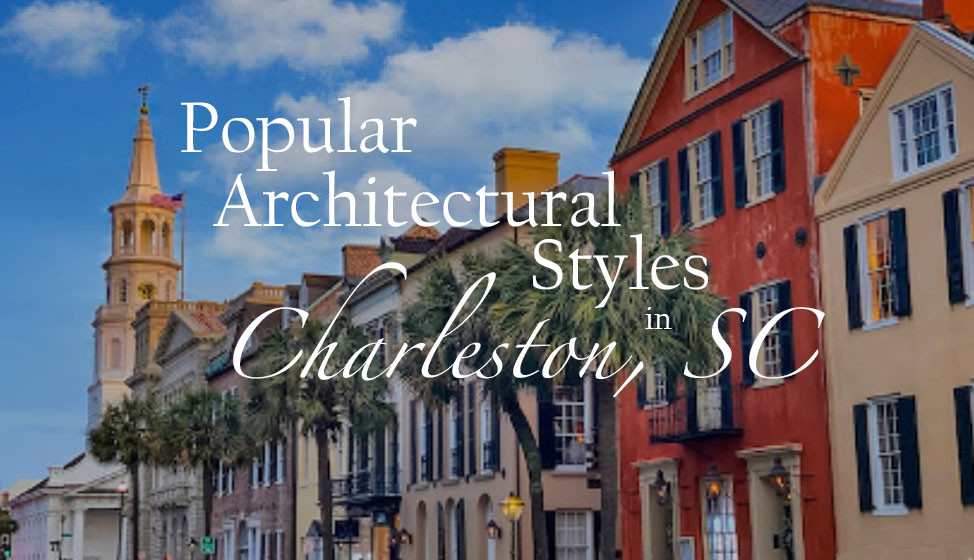Charleston, South Carolina is a city known for its rich history and beautiful architecture. From opulent estates to charming cottages, Charleston is home to a range of architectural styles influenced by different cultural inspirations as well as years of expansion and development. From the Georgian Revival of the Colonial period, to the Greek Revival and Italianate styles of the early 19th century, to the Gothic Revival of the mid-19th century, Charleston’s architecture provides a window into the city’s past.
As a result, today Charleston is not just an amazing tourist destination, it’s also a great place to call home. Let’s take a closer look at some of the popular architectural styles in Charleston and the distinctive qualities that make them cherished by residents and visitors alike. The next time you’re out walking the charming streets of historic downtown Charleston, keep your eyes open to spy each of these examples. Experience the beautiful way they all fit together to create one of the most magical cities in America.
CHARLESTON SINGLE HOUSE
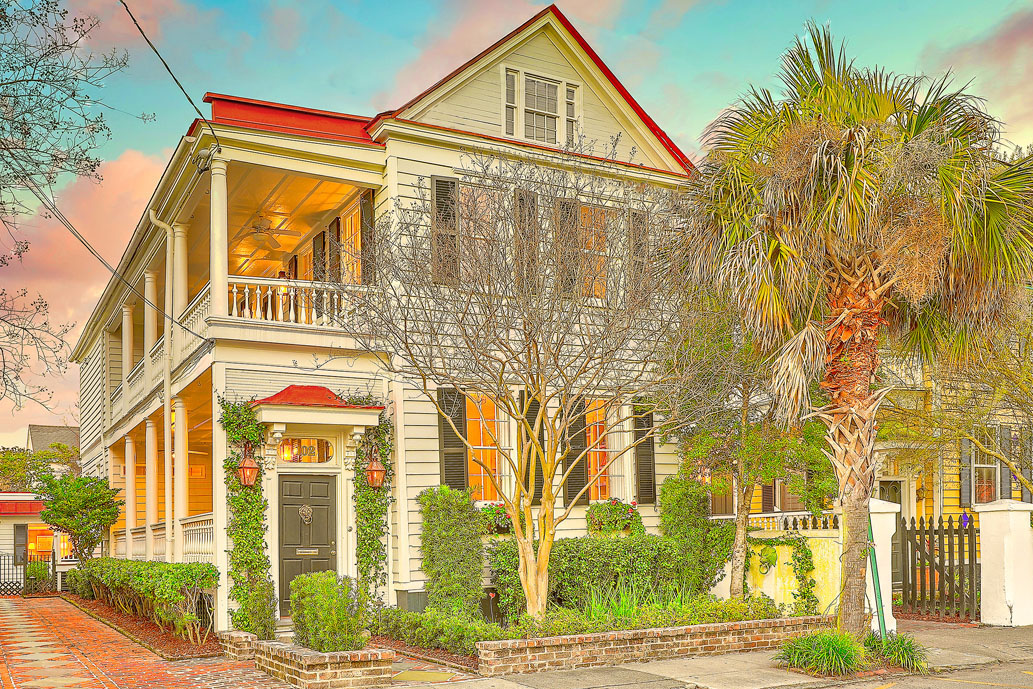 Emerging in the late 18th century, the Charleston single house remains the most popular architectural style in historic downtown Charleston. These long, narrow, two- or three-story structures are one room wide and oriented perpendicular to the street. A covered porch, called a “piazza,” runs the length of the house. What appears to be a front door instead opens to the piazza, with the main entrance located on the side of the building.
Emerging in the late 18th century, the Charleston single house remains the most popular architectural style in historic downtown Charleston. These long, narrow, two- or three-story structures are one room wide and oriented perpendicular to the street. A covered porch, called a “piazza,” runs the length of the house. What appears to be a front door instead opens to the piazza, with the main entrance located on the side of the building.
Single houses are found throughout the city, but are most prevalent in the French Quarter, South of Broad. A great way to see a variety is to partake in a First Friday Art Walk, which will wind you through the alleyways and cobblestone streets of this section of town.
DOUBLE HOUSE
 Double houses were also built starting in the late 18th century, but never reached the widespread popularity of the Charleston single house. These large, two-story homes are two rooms deep by two rooms wide, symmetrically divided by a center stair hall. Unlike single houses, the long facade of the house fronts the street. Piazzas can be placed on the front or side, and often feature intricate wrought-iron railings.
Double houses were also built starting in the late 18th century, but never reached the widespread popularity of the Charleston single house. These large, two-story homes are two rooms deep by two rooms wide, symmetrically divided by a center stair hall. Unlike single houses, the long facade of the house fronts the street. Piazzas can be placed on the front or side, and often feature intricate wrought-iron railings.
GEORGIAN
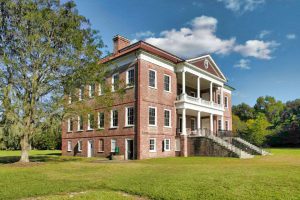 With its pleasing symmetry and simple, yet opulent embellishments, Gregorian style was prevalent in Charleston throughout the 18th century. Its design harkens back to traditional structures from Greece and Rome. In order to convey flawless cohesion, it stresses equilibrium and mathematical dimensions. Georgian structures typically have a flat facade with symmetrical windows and doors. They are frequently decorated with granite pillars, limestone ornamentation, and ornate cornices. This classic style is seen not only in downtown residences and public buildings, but is also closely associated with antebellum plantation houses.
With its pleasing symmetry and simple, yet opulent embellishments, Gregorian style was prevalent in Charleston throughout the 18th century. Its design harkens back to traditional structures from Greece and Rome. In order to convey flawless cohesion, it stresses equilibrium and mathematical dimensions. Georgian structures typically have a flat facade with symmetrical windows and doors. They are frequently decorated with granite pillars, limestone ornamentation, and ornate cornices. This classic style is seen not only in downtown residences and public buildings, but is also closely associated with antebellum plantation houses.
One of the most famous Charleston Georgian structures is Drayton Hall. This 18th-century brick estate with striking double portico is the only Ashley River plantation house to survive the Civil War. It is currently owned by the National Trust for Historic Preservation and is open for public tours. The Heyward-Washington House is another Georgian residence you can visit to see where America’s first president stayed during his visit to the city in 1791.
FEDERAL
 Another neoclassical variation that blossomed in Charleston is Federal, or Adams style architecture. While also based on the classical ideals of order and symmetry, its decorative details are more delicate than Georgian architecture. Look for a center-hall floor plan, an elliptical fanlight over the front door, also flanked by sidelights, and Palladian windows. The exteriors may include octagonal or oval projections with correspondingly-shaped interior rooms.
Another neoclassical variation that blossomed in Charleston is Federal, or Adams style architecture. While also based on the classical ideals of order and symmetry, its decorative details are more delicate than Georgian architecture. Look for a center-hall floor plan, an elliptical fanlight over the front door, also flanked by sidelights, and Palladian windows. The exteriors may include octagonal or oval projections with correspondingly-shaped interior rooms.
Federal style was extensively adopted in Charleston in the decades surrounding the turn of the 19th century. The Nathaniel Russell House, constructed in 1808, is one of Charleston’s (and indeed, America’s) finest examples. It features rectangular, oval, and square rooms on each of three floors. Owned by Historic Charleston Foundation, it has been exquisitely restored to its original condition and is open for public tours. Another Federal home, the Joseph Manigault House, is also available to visit through The Charleston Museum.
VICTORIAN
 Victorian style originated in England during the reign of Queen Victoria (1837-1901) and immediately became fashionable in the US as well. Victorian homes are marked by ornate and detailed design elements. Many feature asymmetrical shapes, steep roofs, large front porches, and intricate ornamentation such as stained glass windows, decorative ironwork, and ornamental shingles. The use of vibrant colors and bold patterns is another a hallmark of Victorian design. As this style persisted for so many decades, it spawned several subgenres.
Victorian style originated in England during the reign of Queen Victoria (1837-1901) and immediately became fashionable in the US as well. Victorian homes are marked by ornate and detailed design elements. Many feature asymmetrical shapes, steep roofs, large front porches, and intricate ornamentation such as stained glass windows, decorative ironwork, and ornamental shingles. The use of vibrant colors and bold patterns is another a hallmark of Victorian design. As this style persisted for so many decades, it spawned several subgenres.
ITALIANATE
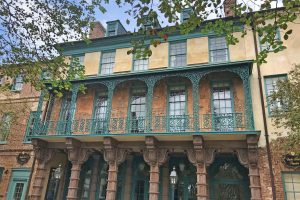 Italianate architecture is a variation of the Victorian style that was all the rage in America in the latter part of the 19th century. It is characterized by rectangular structures with wide-hipped, low-pitched roofs. They are often topped with square cupolas. Windows are tall and usually rounded at the top, without shutters. Decorative corbels with ornate brackets and cornices support overhanging eaves. Italian motifs frequently find their way into masonry and stonework.
Italianate architecture is a variation of the Victorian style that was all the rage in America in the latter part of the 19th century. It is characterized by rectangular structures with wide-hipped, low-pitched roofs. They are often topped with square cupolas. Windows are tall and usually rounded at the top, without shutters. Decorative corbels with ornate brackets and cornices support overhanging eaves. Italian motifs frequently find their way into masonry and stonework.
A fine example of civic Italianate architecture that you can visit today is the Dock Street Theatre. In 1835, it underwent renovations that added a projecting loggia supported by brownstone columns and topped with an ornate cast-iron balcony. Downtown Charleston’s largest private home, the Williams Mansion, is another remarkable example of an Italianate style building.
GREEK REVIVAL
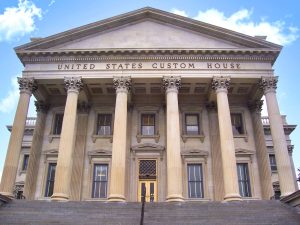 Another recognizable form in Charleston’s architectural history is Greek Revival. This style uses classical Greek components such as columns, pediments, and friezes, and first appeared in the early 19th century.
Another recognizable form in Charleston’s architectural history is Greek Revival. This style uses classical Greek components such as columns, pediments, and friezes, and first appeared in the early 19th century.
The impressive US Custom House, with its stately portico, tall Corinthian columns, and temple fronts, is one of Charleston’s most visible examples of Greek Revival architecture. Another noteworthy instance is the Edmondston-Alston House. This gorgeously maintained home on Charleston’s High Battery is open for tours. Or if you prefer a home that has been preserved without restoration, visit the Aiken-Rhett House. This double house had Greek Revival features added in 1831.
GOTHIC REVIVAL
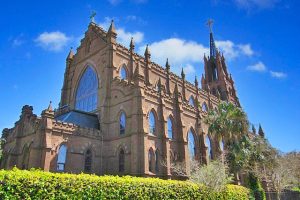 Gothic Revival style draws influence from the medieval era and makes a bold statement on Charleston’s architectural landscape. This style is distinguished by tall towers, rib vaults, elaborate parapets, and a profusion of pointed arched windows. It was commonly used amongst the Holy City’s churches. The Cathedral of Saint John the Baptist, the French Huguenot Church, St. Matthew’s Lutheran Church, the Unitarian Church, and Mother Emmanuel AME all make use of Gothic Revival architecture. It can even be found on much less grand scale, in the outbuildings that make up the urban plantation behind the Aiken-Rhett House.
Gothic Revival style draws influence from the medieval era and makes a bold statement on Charleston’s architectural landscape. This style is distinguished by tall towers, rib vaults, elaborate parapets, and a profusion of pointed arched windows. It was commonly used amongst the Holy City’s churches. The Cathedral of Saint John the Baptist, the French Huguenot Church, St. Matthew’s Lutheran Church, the Unitarian Church, and Mother Emmanuel AME all make use of Gothic Revival architecture. It can even be found on much less grand scale, in the outbuildings that make up the urban plantation behind the Aiken-Rhett House.
If all this talk of Charleston’s architectural diversity and beauty makes you want to visit, or perhaps even move to our beautiful city, be sure to call Disher, Hamrick & Myers for all your Charleston real estate needs. With over 40 years in business downtown, nobody knows the area and the housing market better. If you’re moving to Charleston from another state and searching for long distance movers, don’t forget to team up with the right pros. You’ll be able to get a start on exploring your new city without an ounce of worry while the experts take care of your furniture and possessions. So what are you waiting for? Get out there and enjoy all that Charleston has to offer.

